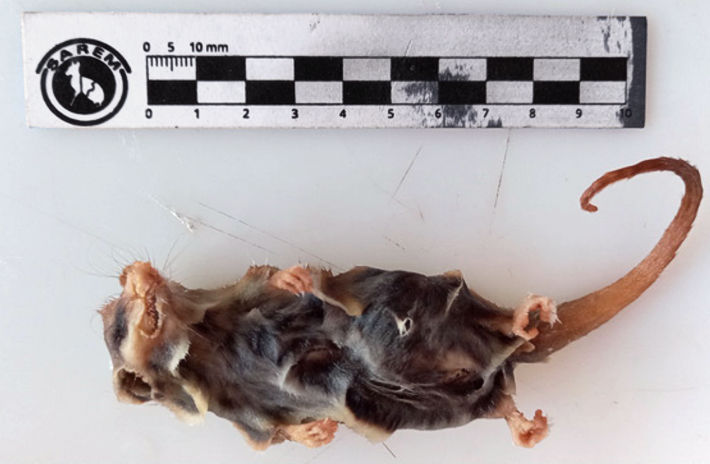Nuevos registros de ocurrencia extienden la distribución norte de Dromiciops (Thomas, 1894) en Argentina
DOI:
https://doi.org/10.31687/saremNMS.21.11.2Palabras clave:
Argentina, distribución, Dromiciops, límite norteResumen
En esta nota reportamos cinco nuevas localidades para el género Dromiciops, a partir de registros con trampas cámara y el hallazgo de un individuo muerto, todos provenientes de bosques de Nothofagus en la provincia del Neuquén (República Argentina). Estos nuevos registros expanden la distribución conocida del género casi 300 kilómetros al norte en su distribución en Argentina. Estas localidades corresponderían, posiblemente, a la especie D. bozinovici.
Citas
Abeli, T., J. C. Vamosi, & S. Orsenigo. 2018. The importance of marginal population hotspots of cold-adapted species for research on climate change and conservation. Journal of Biogeography 45:977–985.
Amico, G. C., M. A. Rodriguez-Cabal, & M. A. Aizen. 2009. The potential key seed-dispersing role of the arboreal marsupial Dromiciops gliroides. Acta Oecologica 35:8–13.
Botero-Delgadillo, E., et al. 2020. Range-wide genetic structure in the thorn-tailed rayadito suggests limited gene flow towards peripheral populations. Scientific Reports 10:1–14.
D'Elía, G., N. Hurtado, & A. D'Anatro. 2016. Alpha taxonomy of Dromiciops (Microbiotheriidae) with the description of 2 new species of monito del monte. Journal of Mammalogy 97:1136–1152.
Echeverría, C., D. Coomes, J. Salas, J. M. Rey-Benayas, A. Lara, & A. Newton. 2006. Rapid deforestation and fragmentation of Chilean temperate forests. Biological Conservation 130:481–494.
Fontúrbel, F. E., E. A. Silva-Rodriguez, N. H. Cárdenas, & J. E. Jiménez. 2010. Spatial ecology of monito del monte (Dromiciops gliroides) in a fragmented landscape of southern Chile. Mammalian Biology 75:1–9.
Goin, F. J., & M. A. Abello. 2013. South American metatherians from the beginning of the Neogene (Early Miocene, Colhuehuapian land-mammal age). Microbiotheria and Polydolopimorphia. Ameghiniana 50:51–78.
Gurovich, Y., H. J. Stannard, & J. M. Old. 2015. The presence of the marsupial Dromiciops gliroides in Parque Nacional Los Alerces, Chubut, Southern Argentina, after the synchronous maturation and flowering of native bamboo and subsequent rodent irruption. Revista Chilena de Historia Natural 88:17.
Hampe, A., & R. J. Petit. 2005. Conserving biodiversity under climate change: the rear edge matters. Ecology Letters 8:461–467.
Lesica, P., & F. W. Allendorf. 1995. When are peripheral populations valuable for conservation? Conservation Biology 9:753–760.
Martin, G., D. Flores, & P. Teta. 2015. Dromiciops gliroides. The IUCN Red List of Threatened Species. 2015:e.T6834A22180239.
Martin, G. M. 2010. Geographic distribution and historical occurrence of Dromiciops gliroides Thomas (Metatheria: Microbiotheria). Journal of Mammalogy 91:1025–1035.
Martin, G. M. 2018. Variability and variation in Dromiciops Thomas, 1894 (Marsupialia, Microbiotheria, Microbiotheriidae). Journal of Mammalogy 99:159–173.
Martin, G. M. 2019a. The palmar and plantar anatomy of Dromiciops gliroides Thomas, 1894 (Marsupialia, Microbiotheria) and its Relationship to Australian Marsupials. Journal of Mammalian Evolution 26:51–60.
Martin, G. M. 2019b. Dromiciops gliroides. Categorización 2019 de los mamíferos de Argentina según su riesgo de extinción. Lista Roja de los mamíferos de Argentina. (SAyDS–SAREM eds.). <http://doi.org/10.31687/SaremLR.19.001>.
Mejías, C., et al. 2021. Natural history of the relict marsupial Monito del Monte at the most extreme altitudinal and latitudinal location. Ecosphere 12:e03577.
Mitchell, K. J., et al. 2014. Molecular phylogeny, biogeography, and habitat preference evolution of marsupials. Molecular Biology and Evolution 31:2322–2330.
Nilsson, M. A., et al. 2010. Tracking marsupial evolution using archaic genomic retroposon insertions. PLoS Biology 8:e1000436.
Nunes, F. L., F. Rigal, S. F. Dubois, & F. Viard. 2021. Looking for diversity in all the right places? Genetic diversity is highest in peripheral populations of the reef-building polychaete Sabellaria alveolata. Marine Biology 168:1–16.
Oda, E., G. B. Rodriguez Gómez, F. E. Fontúrbel, M. Soto-Gamboa, & R. F. Nespolo. 2019. Southernmost records of Dromiciops gliroides: extending its distribution beyond the Valdivian rainforest. Gayana 83:145–149.
Otavo, S., & C. Echeverría. 2017. Fragmentación progresiva y pérdida de hábitat de bosques naturales en uno de los hotspots mundiales de biodiversidad. Revista Mexicana de Biodiversidad 88:924–935.
Quintero-Galvis, J. F., et al. 2021. The Biogeography of Dromiciops in Southern South America: middle Miocene transgressions, speciation and associations with Nothofagus. Molecular Phylogenetics and Evolution 163:107234.
Rodriguez-Cabal, M. A., M. A. Aizen, & A. J. Novaro. 2007. Habitat fragmentation disrupts a plant-disperser mutualism in the temperate forest of South America. Biological Conservation 139:195–202.
Suárez-Villota, E. Y., C. A. Quercia, J. J. Nuñez, M. H. Gallardo, C. M. Himes, & G. Kenagy. 2018. Monotypic status of the South American relictual marsupial Dromiciops gliroides (Microbiotheria). Journal of Mammalogy 99:803–812.
Szalay, F. S. 1994. Evolutionary history of the marsupials and an analysis of osteological characters. Cambridge University Press, New York.
Uribe, S. V., R. G. Chiappe, & C. F. Estades. 2017. Persistence of Dromiciops gliroides in landscapes dominated by Pinus radiata plantations. Revista Chilena de Historia Natural 90:1–5.
Valladares-Gómez, A., J. L. Celis-Diez, R. E. Palma, & G. S. Manríquez. 2017. Cranial morphological variation of Dromiciops gliroides (Microbiotheria) along its geographical distribution in south-central Chile: a three-dimensional analysis. Mammalian Biology 87:107–117.
Vazquez, M. S., M. A. Rodriguez-Cabal, D. V. Gonzalez, G. S. Pacheco, & G. C. Amico. 2018. Different nest predator guild associated with egg size in the Patagonian temperate forest. Bird Study 65:478–483.
Vazquez, M. S., L. B. Zamora-Nasca, M. A. Rodriguez-Cabal, & G. C. Amico. 2021. Interactive effects of habitat attributes and predator identity explain avian nest predation patterns. Emu – Austral Ornithology 121:250–260.

Descargas
Publicado
Cómo citar
Número
Sección
Licencia
Derechos de autor 2021 M. Soledad Vazquez, Débora Viviani, Wenceslao Mora, Mariana Aubone, Guillermo C. Amico

Esta obra está bajo una licencia internacional Creative Commons Atribución-NoComercial 4.0.

